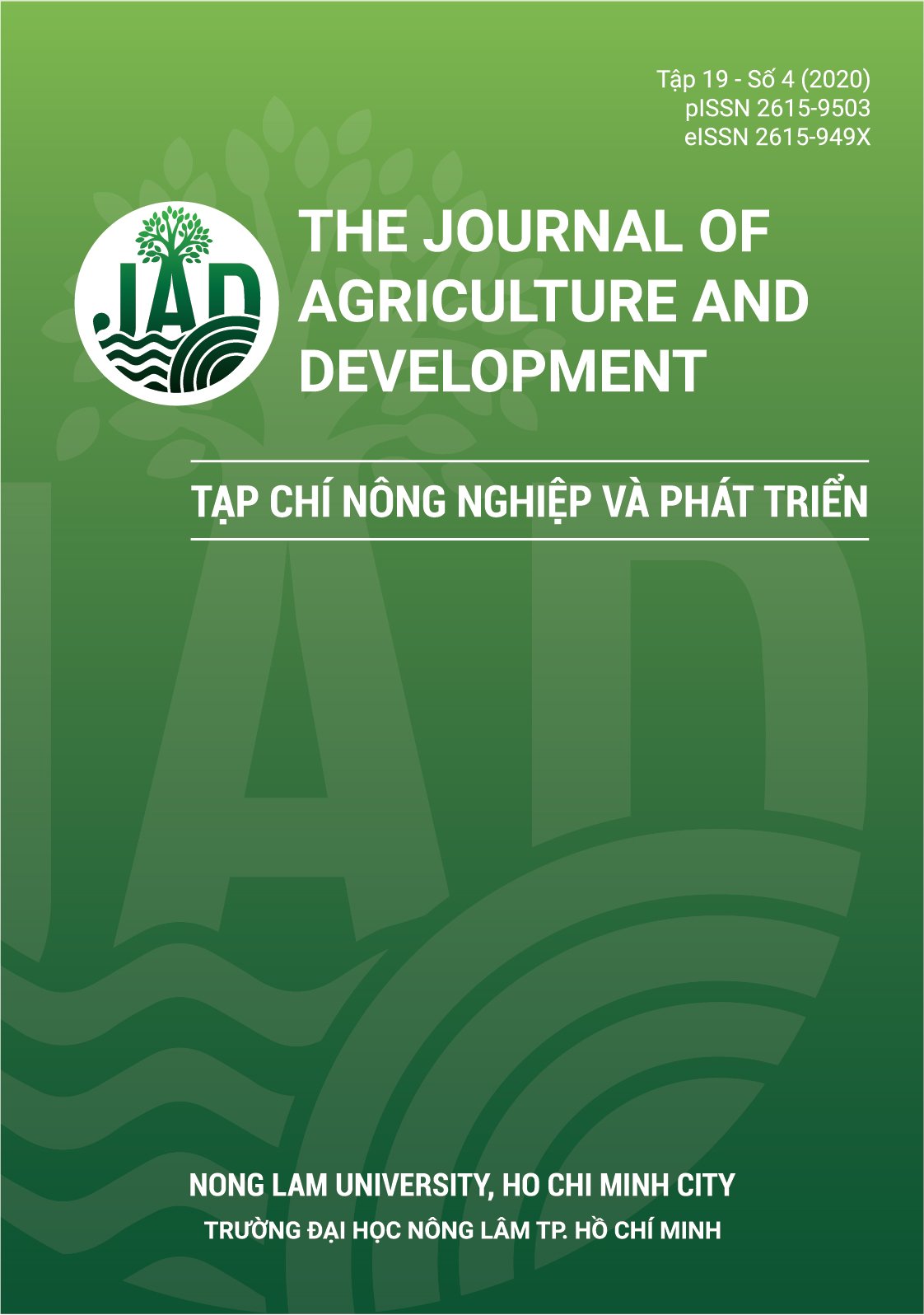Screening of factors influencing the hydrolysis reaction of chicken leg cartilage with Protamex enzyme as a catalyst
Main Article Content
Abstract
The objective of this research was to use Protamex enzyme as a cat-alyst to hydrolyze chicken leg cartilage for production of amino acid hydrolysate. The proximate composition of chicken cartilage was analyzed. The results indicated that the major components in the dry matter of chicken leg cartilage were lipid (19.72 ± 0.05%) and protein (13.34 ± 0.08%). The main parameters affecting the hydrolysis reaction of chicken leg cartilage with Protamex enzyme were selected for investigation: reaction temperature (oC), pH, enzyme ratio (%, based on the weight of substrate), reaction time (min), and the ratio of reaction volume (v/v). The significant difference was analyzed by ANOVA One-Way to identify the optimal point of each parameter toward amino acid yield. The results revealed that the hydrolysis degree and amino acid yield reached the maximal values of 22.93 ± 4.01% and 30.25 ± 1.86%, respectively, when the reaction temperature, pH, enzyme ratio, reaction time, and ratio of reaction volume (v/v) were 40oC, 4, 0.52%, 40 min, and 1/18, respectively.
Article Details
References
Araújo, Í. B. D. S., Bezerra, T. K. A., Nascimento, E.S. D., Gadelha, C. A. D. A., anti-Gadelha, T., & Madruga, M. S. (2018). Optimal conditions for obtain- ing collagen from chicken feet and its characterization. Food Science and Technology 38(Suppl. 1), 167-173. https://doi.org/10.1590/fst.27517
Bui, C. V., Bui, X. D., & Dang, M. N. (2020). Study on hydrolysis reaction of chicken cartilage using enzyme papain. Vietnam Trade and Industry Review 41, 29- 32.
Bui, C. V., Nguyen, M. N. T., Bui, D. X., & Tran, T.V. T. (2018). Screening for optimal parameters of hydrolysis reaction of red meat of Sadar Orientalis with NaOH as a catalyst to obtain protein hydrolysis solution. Journal of Fisheries Science and Technology 2, 16-23.
Bui, C. V., Nguyen, M. N. T., Nguyen, Q. V., Bui, D. X.,& Pham, M. T. (2019). Study on hydrolysis reaction of chicken cartilage using Falvourzyme. UED - Journal of Social Sciences, Humanities Education 9(4), 1-6. https://doi.org/10.47393/jshe.v9i4.106
Bui, D. X., Bui, C. V., Ngo, N. B. T., Pham, T. V.,& Pham, M. T. (2017). Research on the suitable pa- rameters for hydrolysis reaction of red meat of striped tuna (Sarda orientalis) by using commercial protamex. Vietnam Journal of Science and Technology 55(5A), 108-115. https://doi.org/10.15625/2525-2518/55/5A/12185
Horwitz, W. (2010). Official methods of analysis of AOAC International. Agricultural chemicals, contaminants, drugs (Volume I). Maryland, USA: AOAC In- ternational.
Jayathilakan, K., Sultana, K., Radhakrishna, K., & Bawa,A. S. (2012). Utilization of byproducts and waste ma- terials from meat, poultry and fish processing industries: a review. Journal of Food Science and Technology 49(3), 278-293. https://doi.org/10.1007/s13197-011-0290-7
Liaset, B., Julshamn, K., & Espe, M. (2003). Chemical composition and theoretical nutritional evaluation of the produced fractions from enzymatic hydrolysis of salmon frames with ProtamexTM. Process Biochemistry 38(12), 1747-1759. https://doi.org/10.1016/S0032-9592(02)00251-0
Luo, X. M., Fosmire, G. J., & Leach, R. M. (2002). Chicken keel cartilage as a source of chondroitin sulfate. Poultry Science 81(7), 1086-1089. https://doi.org/10.1093/ps/81.7.1086
Mangino, E. (2019). AS/Canada projects slightly slower growth in Canadian chicken meat production for 2020. GAIN Report Number: CA19029. Retrieved April 1, 2020, from https://apps.fas.usda.gov/newgainapi/api/report/downloadreportbyfilename?filename=Poultry%20and%20P roducts%20Annual_Ottawa_Canada_8-29-2019.pdf
Meeker, D. L. (2006). Essential Rendering - All about the animal by-products industry. Virginia, USA: Nationalenderers Association.
Nakano, T., & Sim, J. S. (1995). A study of the chemical composition of the proximal tibial articular cartilage and growth plate of broiler chickens. Poultry Science 74(3), 538-550. https://doi.org/10.3382/ps.0740538
Nguyen, H. T. M., Sylla, K. S. B., Randriamahatody, Z., Donnay-Moreno, C., Moreau, J., Tran, L. T., & Bergé,mJ. P. (2011). Enzymatic hydrolysis of yellowfin tuna (Thunnus albacares) by-products using Protamex protease. Food Technology and Biotechnology 49(1), 48-55.
Pope, C. G., & Stevens, M. F. (1939). The determination of amino-nitrogen using a copper method. Biochemical Journal 33(7), 1070-1077. https://doi.org/10.1042/bj0331070
Seyer, J. M., Brickley, D. M., & Glimcher, M. J. (1974). The identification of two types of collagen in the articular cartilage of postnatal chickens. Calcified Tissue Research 17(1), 43-55. https://doi.org/10.1007/BF02547213
Thureen, P. J. (2012). Neonatal nutrition and metabolism. Cambridge, UK: Cambridge University Press.
Wisuthiphaet, N., Klinchan, S., & Kongruang, S. (2016). Fish protein hydrolysate production by acid and enzymatic hydrolysis. International Journal of Applied Science and Technology 9(4), 261-270.








